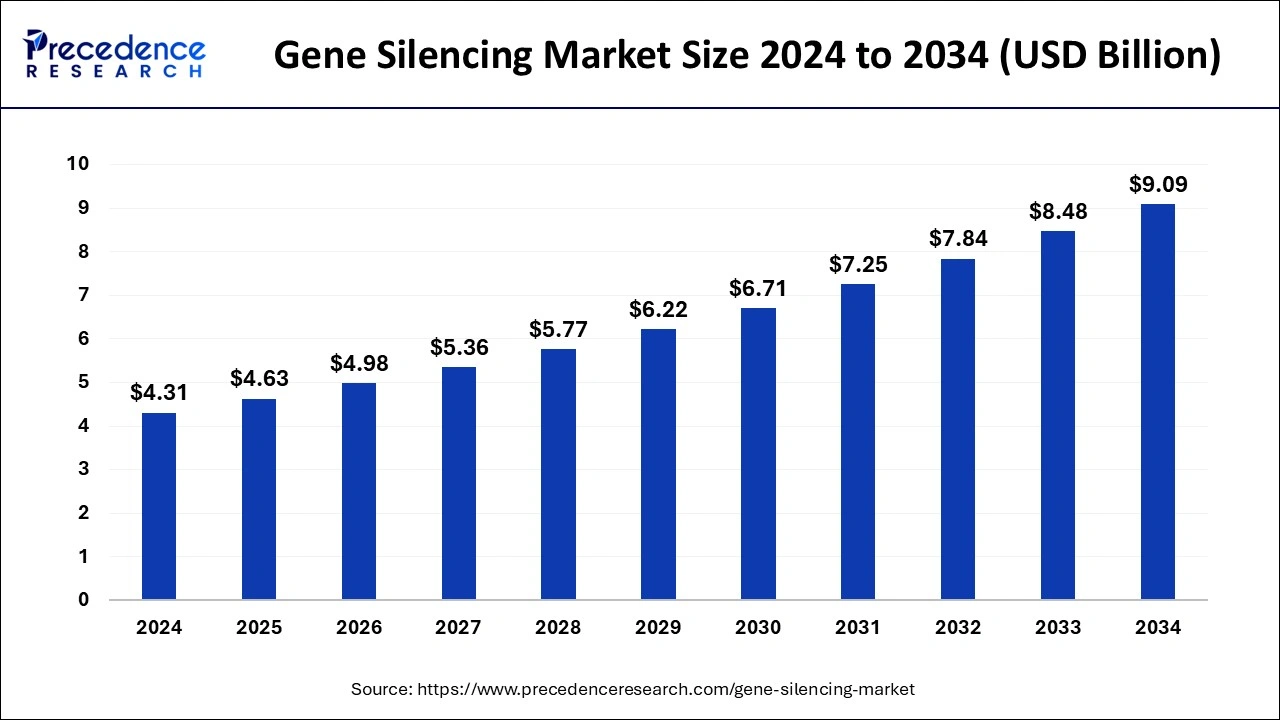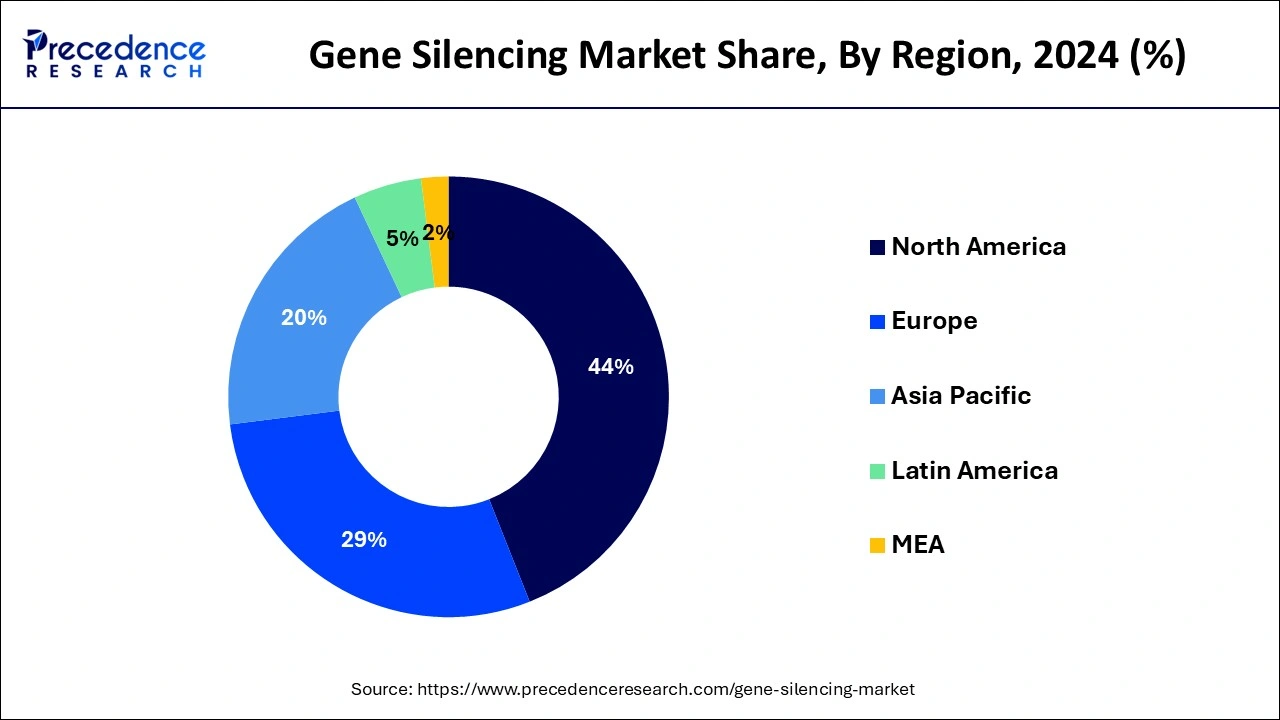February 2025
The global gene silencing market size is calculated at USD 4.63 billion in 2025 and is forecasted to reach around USD 9.09 billion by 2034, accelerating at a CAGR of 7.75% from 2025 to 2034. The North America gene silencing market size surpassed USD 1.90 billion in 2024 and is expanding at a CAGR of 7.78% during the forecast period. The market sizing and forecasts are revenue-based (USD Million/Billion), with 2024 as the base year.
The global gene silencing market size was estimated at USD 4.31 billion in 2024 and is predicted to increase from USD 4.63 billion in 2025 to approximately USD 9.09 billion by 2034, expanding at a CAGR of 7.75% from 2025 to 2034.

The U.S. gene silencing market size was estimated at USD 1.33 billion in 2024 and is projected to hit around USD 2.85 billion by 2034, poised to grow at a CAGR of 7.92% from 2025 to 2034.

North America held the largest market share of 44% in 2024 propelled by various factors, among which robust research and development initiatives stand out prominently. The region benefits from its advanced healthcare infrastructure, substantial investments in biotechnology, and supportive regulatory frameworks, all of which foster innovation and the development of cutting-edge gene therapies. This environment encourages collaboration among academic institutions, pharmaceutical companies, and startups, creating a dynamic landscape for advancements in gene therapy.
Additionally, the increasing prevalence of genetic disorders and the growing demand for personalized medicine further drive the growth of the gene silencing market in North America. These factors position the region as a leading hub for gene silencing research and adoption, driving continuous innovation and development in the field.

In Asia Pacific, rapid growth is anticipated at a CAGR of 9.6% in the global gene silencing market. This growth is attributed to the region's large population with unmet medical needs and an increasing demand for novel technologies to address rare but increasingly prevalent diseases. As healthcare systems in Asia Pacific continue to evolve and investments in biotechnology increase, the region is poised to play a significant role in the global gene silencing market, contributing to advancements in medical treatments and technologies.
The gene silencing market refers to an epigenetic mechanism that modifies gene expression, resulting in the deactivation of specific genes at the transcriptional or translational levels, or even across larger chromosome regions. It represents a modern treatment approach leveraging the body's natural processes to combat diseases by suppressing or "silencing" particular genes associated with various medical conditions. Gene silencing holds promise as a therapeutic strategy across a spectrum of disorders, including cancer, infectious diseases, and immune disorders. By targeting specific genes responsible for disease manifestation, this technique aims to mitigate the underlying molecular mechanisms driving pathology, offering new avenues for treatment and intervention in diverse medical contexts.
Gene slicing is a pivotal technique in the field of gene therapy, enabling precise modifications of genetic material. Its significance stems from the potential to address genetic disorders, including inherited diseases, through the replacement or repair of defective genes. As gene therapy progresses, the ability to splice genes accurately becomes essential for creating targeted and efficient treatments. This innovative approach offers hope for enhanced patient outcomes and has the capacity to revolutionize healthcare by offering personalized solutions for genetic conditions. Gene slicing represents a crucial step forward in the quest to address genetic disorders and improve the quality of life for individuals affected by these conditions.
| Report Coverage | Details |
| Growth Rate from 2025 to 2034 | CAGR of 7.75% |
| Market Size in 2025 | USD 4.63 Billion |
| Market Size by 2034 | USD 9.09 Billion |
| Base Year | 2024 |
| Forecast Period | 2025 to 2034 |
| Segments Covered | By Type and By Application |
| Regions Covered | North America, Europe, Asia-Pacific, Latin America, and Middle East & Africa |
Rising Incidence of genetic disorders
The statement underscores the significant burden of genetic and congenital diseases on prenatal and neonatal mortality rates in various regions. Genetic factors play a pivotal role in the onset of many multifactorial ailments, contributing to their severity and complexity. These diseases often affect multiple bodily systems and pose challenges for effective treatment due to their underlying genetic alterations.
While certain genetic disorders can be managed or treated with gene silencing techniques, many treatment approaches do not address the underlying genetic abnormalities. Factors such as mutations, chemical exposure, and radiation can contribute to the development of genetic disorders, further emphasizing the need for effective therapeutic interventions. The increasing prevalence of genetic abnormalities across different age groups and geographic regions serves as a key driver for the growth of the global gene silencing market. As the demand for innovative treatment modalities rises to address the complexities of genetic disorders, the gene silencing market is expected to expand to meet these healthcare challenges.
High cost of gene silencing treatments
The high cost of gene silencing treatments presents a significant barrier to access for many patients. Gene silencing involves manipulating genetic information to treat various conditions, and while it holds great promise for once-intractable diseases, pricing remains largely unregulated in many countries, often requiring substantial upfront payments.
The exorbitant costs associated with gene silencing therapies pose a significant challenge for patients seeking access to these potentially life-changing treatments. As more gene silencing products become available, the treatment landscape for rare genetic diseases may undergo substantial changes, offering patients curative options for the first time.
However, ensuring equitable access to these cutting-edge therapies remains a critical concern. Healthcare systems worldwide must address the disparity in access to gene silencing treatments, ensuring that all patients, regardless of financial means or privilege, have the opportunity to benefit from these innovative therapies. Addressing the cost barrier is essential to ensuring that gene silencing treatments can fulfill their promise of transforming the lives of patients affected by genetic conditions.
Increase in strategic acquisitions and partnerships among organizations
The rise in strategic acquisitions and partnerships among organizations in the field of gene silencing is significantly shaping the landscape of genetic disorder detection and treatment. Collaborations between different entities are aimed at developing innovative gene silencing products crucial for detecting and addressing genetic disorders effectively. These partnerships enable companies to combine their expertise and resources to develop new technologies and platforms tailored to disease detection. Through long-term agreements, companies can offer competitive pricing of gene silencing products, aligning with market demand and consumer needs. Such collaborations not only benefit the participating companies but also open up numerous growth opportunities for the gene silencing market as a whole.
Overall, the increasing trend of collaboration and partnerships in the gene silencing market is expected to foster innovation, expand market reach, and ultimately contribute to the advancement of genetic disorder detection and treatment.
The transcriptional segment dominated the gene silencing market with 53% in 2024. The transcriptional segment in the gene silencing market is primarily driven by its capability to induce long-lasting and heritable changes in gene expression. Transcriptional gene silencing mechanisms, such as DNA methylation and histone modification, play crucial roles in regulating gene expression patterns by modulating chromatin structure and accessibility to transcriptional machinery. This segment is particularly advantageous for researchers and biotechnologists seeking stable and enduring suppression of target genes across multiple cell generations or in whole organisms.
In addition, the versatility of transcriptional gene silencing techniques allows for the modulation of entire gene loci, providing a comprehensive approach to gene regulation. As the understanding of epigenetics and chromatin biology deepens, the demand for transcriptional gene silencing technologies is expected to grow, especially in areas such as developmental biology, disease modeling, and therapeutic intervention strategies aimed at modulating gene expression profiles for various applications.
The post-transcriptional segment is expected to witness a substantial growing CAGR of 8.8% during the forecasted period. The post-transcriptional segment in the gene silencing market is primarily driven by its ability to modulate gene expression at the RNA level, offering precise and efficient control over target gene activity. Post-transcriptional gene silencing mechanisms, such as RNA interference (RNAi) and antisense oligonucleotide (ASO) technologies, enable the selective degradation or inhibition of specific RNA molecules, thereby regulating protein synthesis and function. This segment is particularly advantageous for researchers and clinicians seeking to manipulate gene expression dynamically and transiently in response to changing physiological conditions or disease states. Post-transcriptional gene silencing techniques offer a high degree of specificity, allowing for the selective targeting of individual transcripts or splice variants implicated in disease pathways.
The neurological diseases treatment segment dominated the gene silencing market with 41% in 2024. The treatment of neurological diseases represents a pivotal segment in the gene silencing market, driven by several factors. One key driver is the growing prevalence of neurological disorders globally, including conditions such as Alzheimer's disease, Parkinson's disease, amyotrophic lateral sclerosis (ALS), and various genetic neurological disorders. With aging populations and changing lifestyles contributing to the rise in neurological diseases, there is an urgent need for innovative and effective treatment approaches.
Gene silencing offers a promising therapeutic strategy for neurological diseases by targeting specific genes associated with disease pathology. This approach allows for the selective inhibition or modulation of gene expression, potentially slowing disease progression or even reversing neurodegenerative processes. Additionally, advancements in gene editing technologies, such as CRISPR-Cas9, have facilitated more precise and targeted interventions in neurological disorders.
By Type
By Application
By Geography
For inquiries regarding discounts, bulk purchases, or customization requests, please contact us at sales@precedenceresearch.com
No cookie-cutter, only authentic analysis – take the 1st step to become a Precedence Research client
February 2025
January 2025
February 2025
November 2024